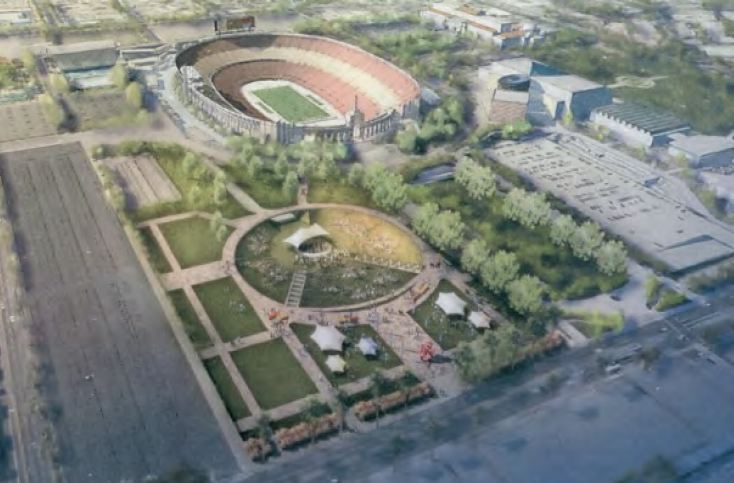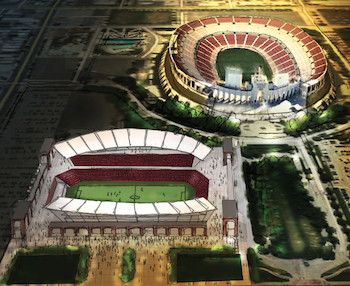L.A. Sports Arena Releases Draft Environmental Impact Report

The Los Angeles Memorial Sports Arena could be demolished, yielding to either an amphitheater or a soccer stadium under draft plans released earlier this week to reinvigorate the publicly managed, cash-strapped and deteriorating entertainment venue that has been short on programming.
In an under-the-radar fashion recently typical of the the body that oversees the 15-acre Sports Arena campus near Exposition Park, the L.A. Memorial Coliseum Commission released a 347-page draft environmental impact report for the dueling project options on Monday. It's unclear how the demolition and redevelopment would be funded.
The soccer stadium option is the third vision for a new sports facility in Los Angeles County, following Ed Roski's plan for an NFL stadium in the City of Industry and an AEG proposal also released this week for a $725 million stadium that would be designed to house an NFL team and the World Cup.
The Sports Arena has come under scrutiny during recent weeks because its financial woes may have forced the Coliseum Commission to suprisingly rescind a ban on electronic music festivals, more commonly known as raves, at the facility. The festivals have been one of the few steady streams of revenue for the aging facility, likely bringing in a few hundred thousand dollars annually. The release of the draft environmental impact report officially brings the commission to a crossroads.
As early as January, the nine people who sit on the panel will have to decide to do one of three things: go forward with the soccer stadium idea and mount a challenge to proposals of Roski and AEG; construct an amphitheater and hope people make good use of it; or launch a smaller renovation of the existing facility while watching it sink into a deeper operating deficit.
The amphitheater option would feature an 800-square-foot stage backed by an open half-dome shell and a large grass field flanked by flag poles. Not included in the plans are any fixed seats, video boards or fencing. Concession stands and restrooms "may be provided," the report says. Events that could be held here include Farmer's Markets, rallies, festivals, exercise groups, concerts, neighborhood carnivals and special ceremonies.

The plan mentions no outisde retail or dining components--items that may ultimately be needed for financial viability.
The stadium, which would be oriented the same way as the arena is right now, would also hold concerts and rallies. If USC's team moves into this new stadium, it's current field near Hoover Street and 30th Street would likely become available for USC to develop on.
The seven-story Sports Arena opened 51 years ago amid a nationwide boom in arena construction, providing the region its first new sports venue in about 25 years.
Most of the arena's highlights came in its first few years of existence, hosting boxing, basketball, hockey, the 1960 Democratic National Convention and the 1961 Freedom Rally at which Dr. Martin Luther King Jr. spoke.
But professional sports franchises such as the Lakers and Kings quickly moved to other location such as The Forum and Pauley Pavilion. Only the Clippers would come play at the arena from 1984 to 1999.
During the past five years, an event has been held there, on average, only once every six days. Nearly all of the events attracted less than 10,000 people. In comparison, the Staples Center held about four times as many events, according to the website of its owner, AEG.
Most of the environmental impacts mentioned in the report are routine ones that one would expect from a major construction project. Lighting and noise may anger residents living along Martin Luther King Jr. Boulevard. But because the Sports Arena is built in a big ditch, the stadium and amphitheater would also maintain low profiles.
The parking and traffic situation would also change very little because even if the Coliseum and Sports Arena held concurrent events, overall capacity would be limited to about the same level as right now. About 20,000 parking spaces exist throughout Exposition Park and USC, and no additional ones would have to be added.
The report states the Sports Arena needs $8.2 million in upgrades--from new seats to new plumbing and heating systems--within the next five years to keep operating. Each of the past five fiscal years, however, has brought operating losses totaling nearly $4 million. Because the commission doesn't receive any taxpayer subsidies, it doesn't have the cash to pay for those fixes. The document notes that even if improvements were made, the Sports Arena would not be any more competitive with venues such as the 19,000-seat Staples Center.
The arena's present configuration allows it hold about 15,000 people for hockey, boxing and basketball events.
L.A. Coliseum Commission general manager Pat Lynch has not responded to several voicemails left by Neon Tommy during the past two weeks. Members of the Coliseum Commission, including L.A. County supervisors Mark Ridley-Thomas and Zev Yaroslavsky, L.A. City Councilman Bernard Parks and real estate developer Rick Caruso, could not be reached for comment.
The 45-day public comment period on the draft report runs until Dec. 30. It seems wise for public agencies, including the L.A. City Council and the L.A. County Board of Supervisors, to ask for an extension of that comment period since it runs right through two major holiday periods.
Either way, comments should be directed to Coliseum general manager Pat Lynch at 3939 S. Figueroa St., Los Angeles, CA 90037. The report is available online, at the previous address and at the Exposition Park Library. The online PDF is also "secured," so text from the document can't be copied and pasted.
Under a joint agreement between the state, city and county, the Coliseum Commission maintains and operates the Coliseum and Sports Arena. That agreement runs through 2054.
Los Angeles voters thrice rejected measures to publicly finance the construction of a Downtown sports arena. Urged on by County Supervisor Kenneth Hahn, the state Legislature eventually jumped in, authorizing in 1958 the sale of $7 million in bonds to build the present arena. Before the Exposition Park project was settled on, there were three competing visions of "world-class" arenas across Los Angeles.
The Coliseum has stood since 1923. The commission has existed since 1945.
For continuing coverage of the redevelopment project, either follow me on Twitter or subscribe to this special RSS feed.
Reach executive producer Paresh Dave here. Follow him on Twitter: @peard33.



